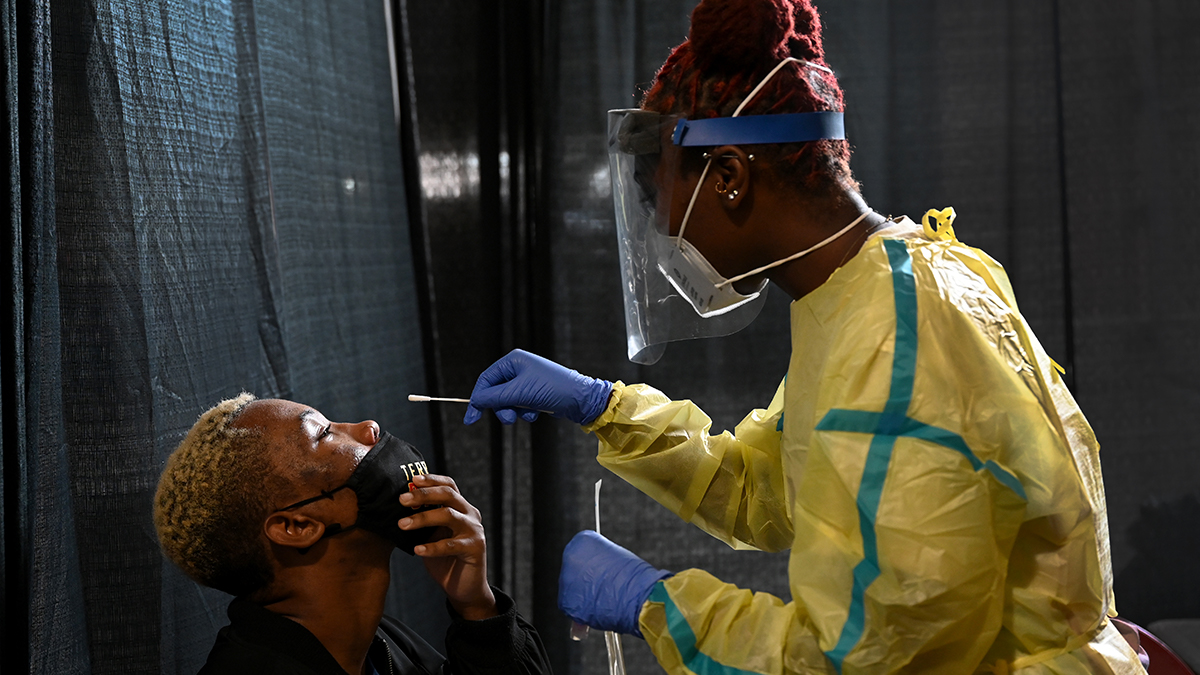Virginia and Maryland are seeing an upward trend in cases. Counted on a seven-day average, the number of new infections is rising in Virginia. Maryland is seeing a similar rise, but with less dramatic numbers.
The District continues to be in a relative plateau of new cases, but the data could be lagging amid a massive demand for tests. When D.C. began rolling out walk-up, appointment-free test sites, the city promised results in 3-5 days.
Now, it's taking a week for residents to get results back, News4 reported. Some reported waiting 10 days.
A quicker turnaround time really matters if someone is infected, said Dr. Travis Gayles, the Montgomery County health officer.
“You’re shortening as best you can the window of opportunity for when an individual is positive, may come into contact with others and potentially infect them,” he said.
The city is reportedly seeking out more lab capacity to shorten wait times.
What the Data Shows
The number of new COVID-19 cases diagnosed in Virginia each day has been ticking up since a low point in late June.
But the 904 new infections recorded on Friday is the highest single-day increase the state has seen in over a month. It's nearly 300 cases larger than the number that was added the previous day, 608.
More time and data is needed to tell if this is an outlying spike. The last time Virginia counted more than 900 new cases was June 7.
There was an additional 868 cases Saturday, bringing the total number of confirmed cases in Virginia to 66,963.
Spikes can occur because of a backlog of test results being announced. However, Virginia's seven-day average of new cases has been trending upward this month.
Outside the commonwealth, Maryland's trend in growing new cases continues.
In the District, an overall plateau continues but the new case numbers have fluctuated in the past week. In the past week, July 4 had a low number with 12 new infections. Wednesday had a jump of 73 cases, on Thursday reported 37 new cases and rose to 64 on Friday. The District reported 58 news cases on Saturday.
The map below shows the number of coronavirus cases diagnosed per 1,000 residents.
Coronavirus Cases in DC, Maryland and Virginia
COVID-19 cases by population in D.C. and by county in Maryland and Virginia
Source: DC, MD and VA Health Departments
Credit: Anisa Holmes / NBC Washington
Local Coronavirus Headlines
- Virginia's governor said he could bring back tougher restrictions after the state reported more than 900 new coronavirus infections Friday, the highest daily total in more than a month. Read more.
- Prince George's County remains among the top 50 U.S. counties for coronavirus infections, but the metrics are improving. Read more.
- D.C. is seeing up to a 7-day wait for individuals' coronavirus test results to come back as demand increases. Read more.
- Prince Geoge's County Executive Angela Alsobrooks bit back at the idea that the area bore a high case burden because it's a majority-black county with a high Latino population.
"What we know is that our county is dense and urban. We house one of the largest segments of the federal workforce. Along with a good number of our residents are essential workers," she said.
Reopening Tracker
- Virginia entered phase three reopening on July 1, loosening restrictions on restaurants, stores, gyms and pools.
- Prince George's County entered full phase two on June 23, allowing the MGM Casino and gyms to reopen.
- Washington, D.C., entered phase two on June 22, allowing indoor dining, gyms, libraries and houses of worship to reopen with restrictions.
- Montgomery County entered phase two on June 19, reopening with restrictions gyms, houses of worship, indoor dining and retail.
- Maryland entered phase two of reopening on June 10, permitting indoor dining, outdoor pools and outside amusements to reopen.
How to Stay Safe
There are ways to lower your risk of catching coronavirus. Here are the CDC guidelines.
- Wear a snug-fitting mask that covers your nose and mouth.
- Avoid being indoors with people who are not members of your household. The more people you are in contact with, the more likely you are to be exposed to COVID-19. If you are indoors with people you don’t live with, stay at least six feet apart and keep your mask on.
- Wash your hands often, especially after you have been in a public place.
Sophia Barnes, Andrea Swalec and Anisa Holmes contributed to this report.
This story is no longer being updated. Go here for the updates on July 12.



